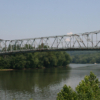Overview
The history of the Morris Island Lighthouse spans over 100 years. The lighthouse is located on Morris Island in South Carolina, near Charleston Harbor. Signaling was first initiated at this location in 1673, this consisted of a raised metal pan filled with pitch and lit every night. The first lighthouse was constructed in 1767. The current structure is 161 feet (50m) high and was completed and put into service in 1876. It was then automated in 1938 and, finally, deactivated in 1962. At the time of its construction, it was located approximately 1,600 (500m) feet from the water. Now, it is located only several hundred feet (100m) offshore due to erosion created by the alteration of ocean currents that occurred in 1889 when jetties were constructed in the area. In 1938, automation was necessary as it was not considered safe for anyone to man the lighthouse as the shoreline had reached the lighthouse itself. The keepers quarters were destroyed the following year. The year 1962 brought decommissioning of the historical light due to continued erosion. In 1999, the historic lighthouse was purchased by Save the Light Inc. in order to undertake preservation. As of 2000, ownership was given to the State of South Carolina and leased to Save the Light Inc. in order to move forward with fundraising and restoration efforts, which included erosion control and stabilization.
In 2007 work began on stabilizing the foundation of the lighthouse. This work consisted of constructing a sheet-pile cofferdam (shown at right) around the lighthouse, dewatering the foundation and then injecting grout below the foundation. Traylor Brothers Marine was contracted to perform this work.
Traylor had to contend with difficult site conditions including poor weather, high wind and surf, and salt water. More information on the lighthouse and the preservation efforts can be found at http://www.savethelight.org
What We Did
An instrumentation program was designed by the consulting engineers, WrightPadgetChristopher, to monitor the stability of the lighthouse during construction of the cofferdam and grouting. This instrumentation consisted of tiltmeters mounted on the inside of the lighthouse at various heights, crackmeters to monitor displacement, and weather monitoring including rainfall, wind speed and direction, air and water temperature, barometric pressure and humidity.
We provided a solar powered monitoring system using a Campbell Scientific CR10X for the project. This includes our VWDSP Interface to provide high-quality vibrating wire measurements and our MiniMux multiplexer. For communications a MultiTech GPRS modem provides 24/7 access to the system using cellular IP. System management and data collection is accomplished using MultiLogger along with Internet connectivity.
Monitoring Data
During construction of the cofferdam and grout injection the stability of the lighthouse was monitored in near real-time. This allowed careful attention to structural integrity particularly during the grouting operations. In between active construction work a longer measurement interval provides long-term stability monitoring.
Several parties including the construction contractor, consulting engineers and the owner also needed access to the data during and after construction work, this is facilitated by using MultiLoggerDB to store collected data in a SQL database, then our MLWeb software provides 24-hour access to the up-to-date instrumentation data. A view of the web interface depicting the lighthouse and instrument locations and current readings is shown at right. The automation capabilities of MultiLoggerDB are also used to automatically deliver data reports and charts thereby saving time in the management of the system and data.


